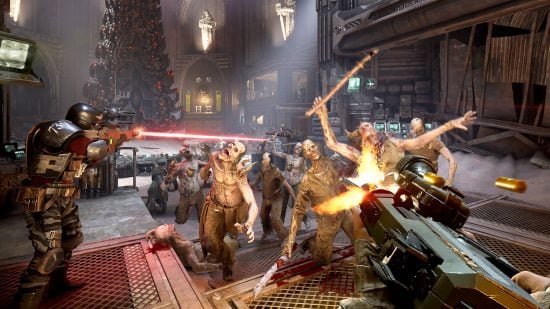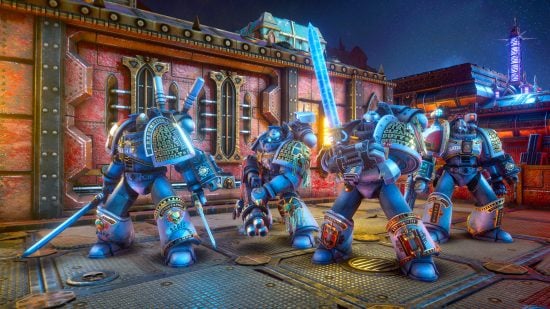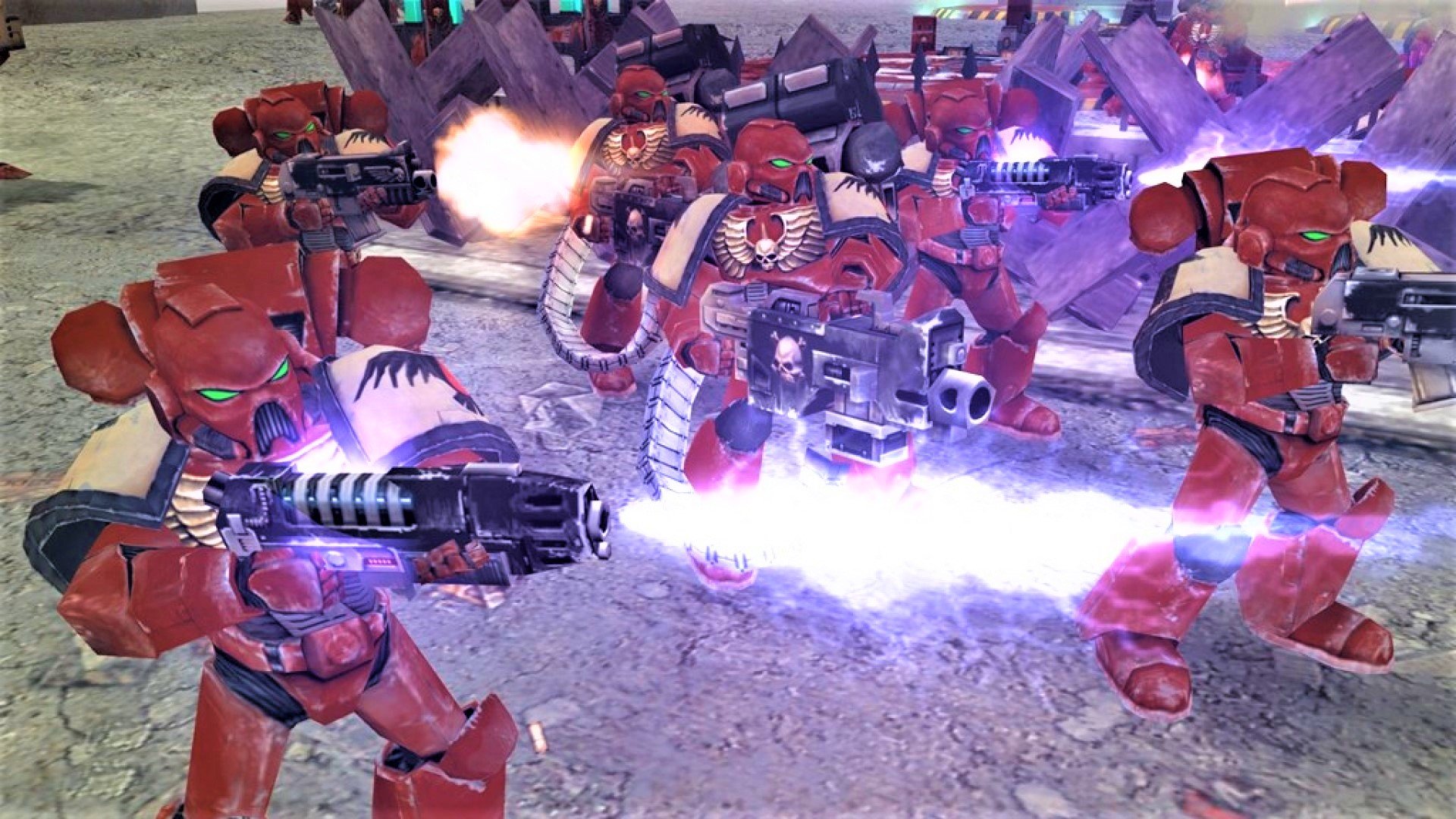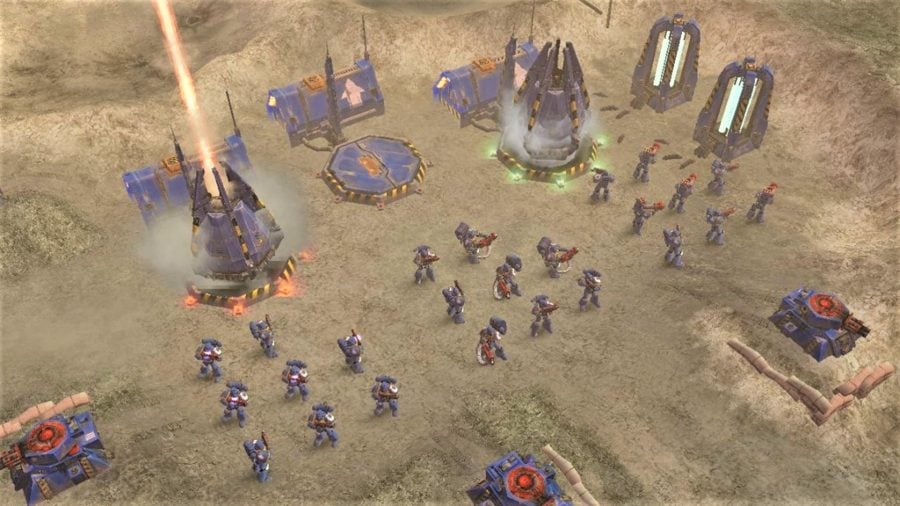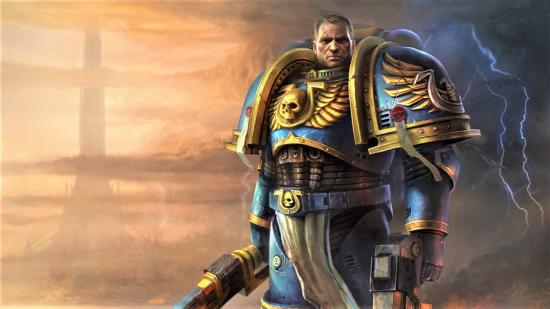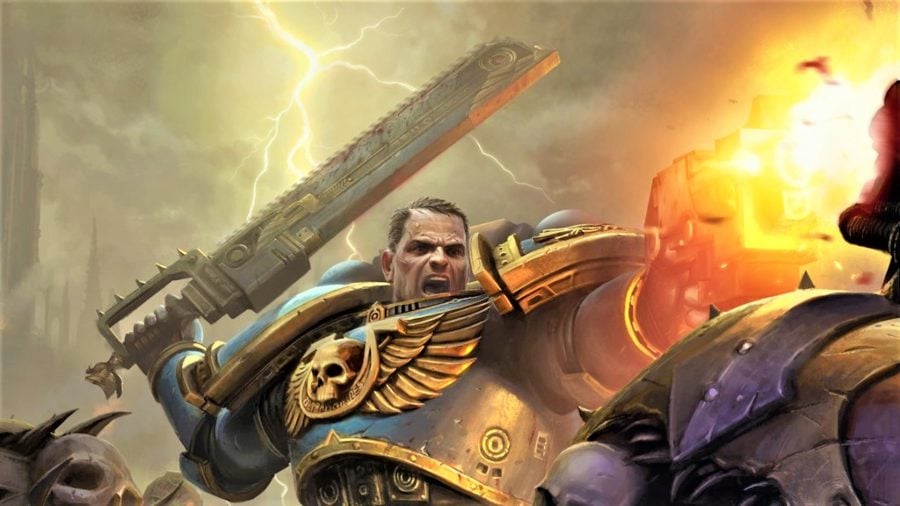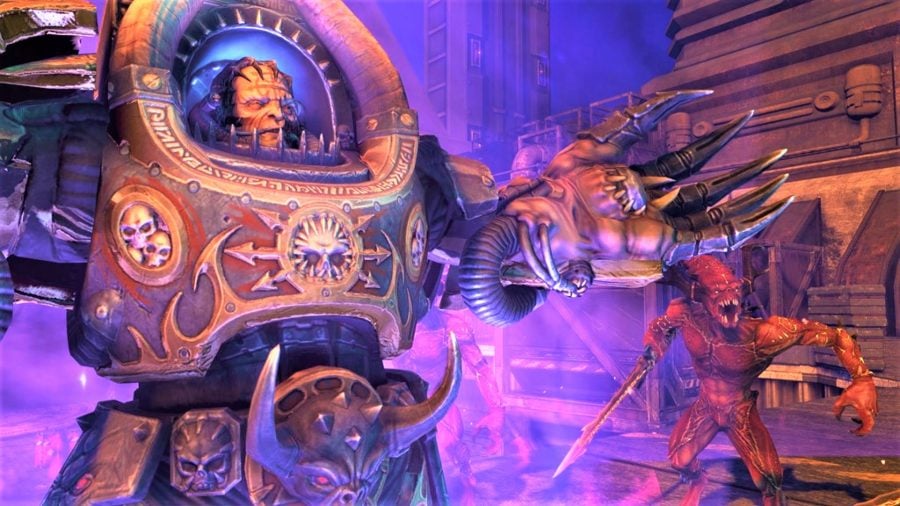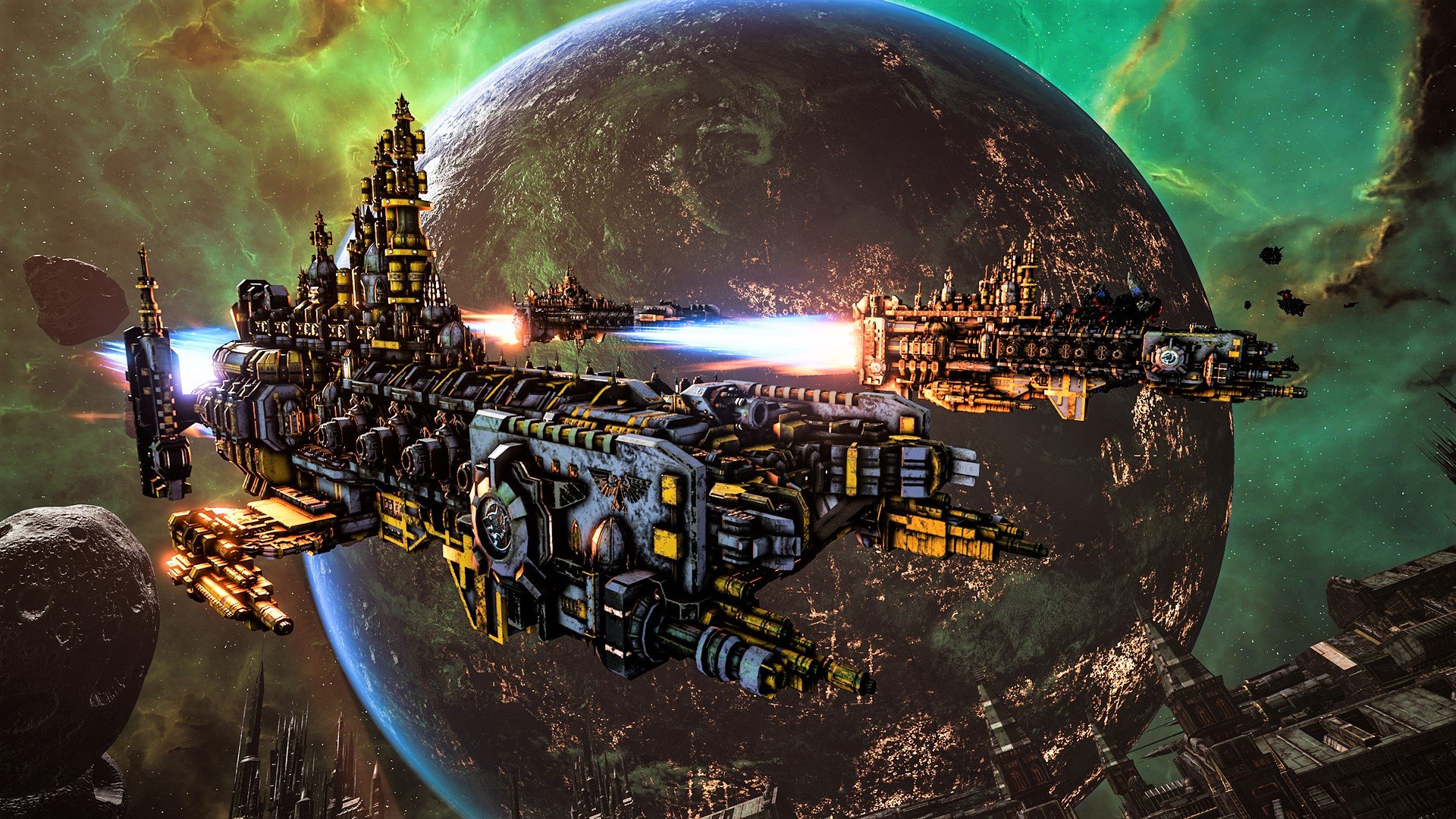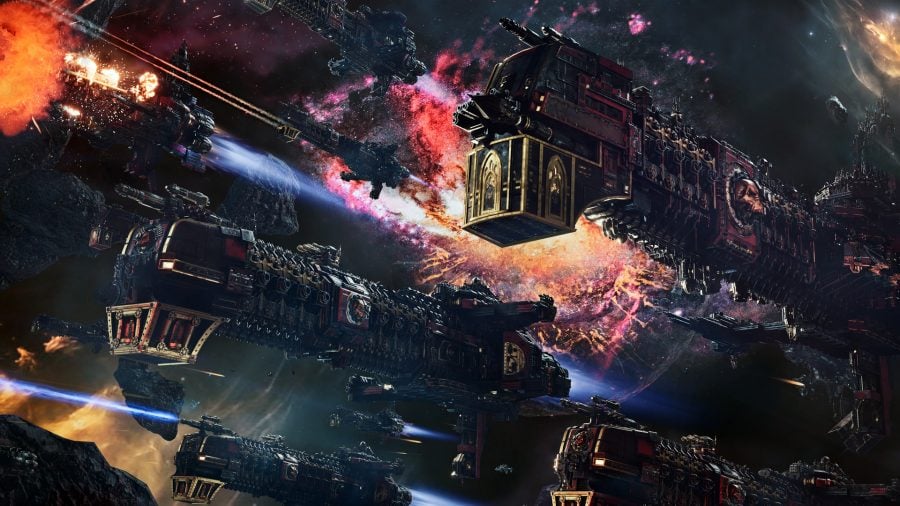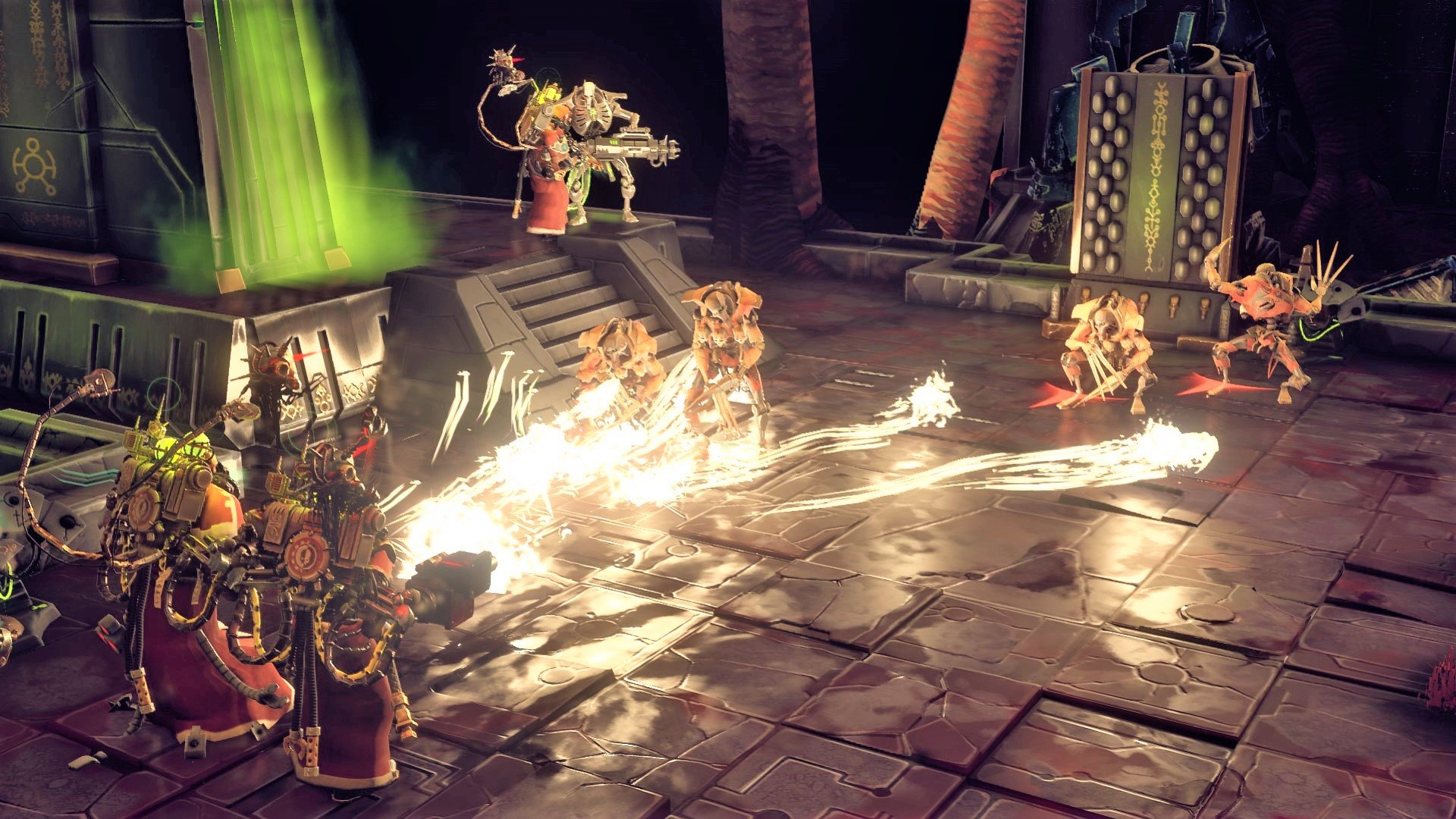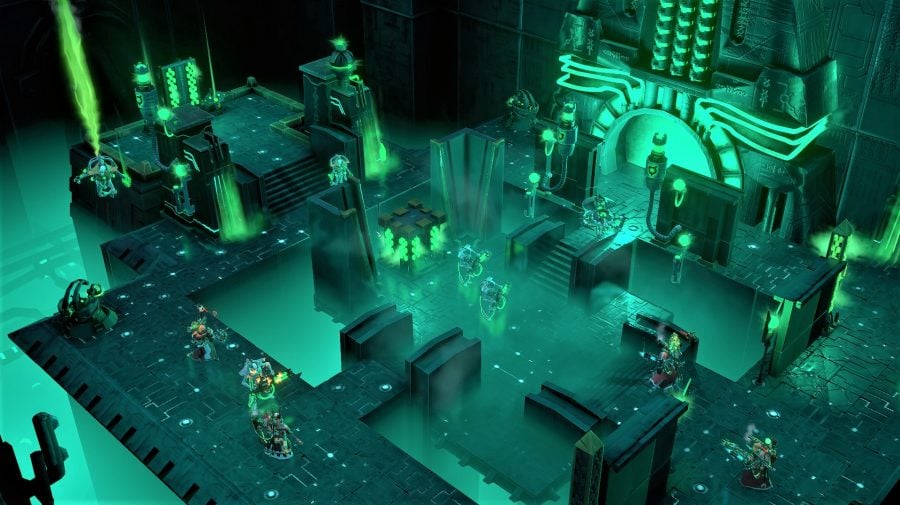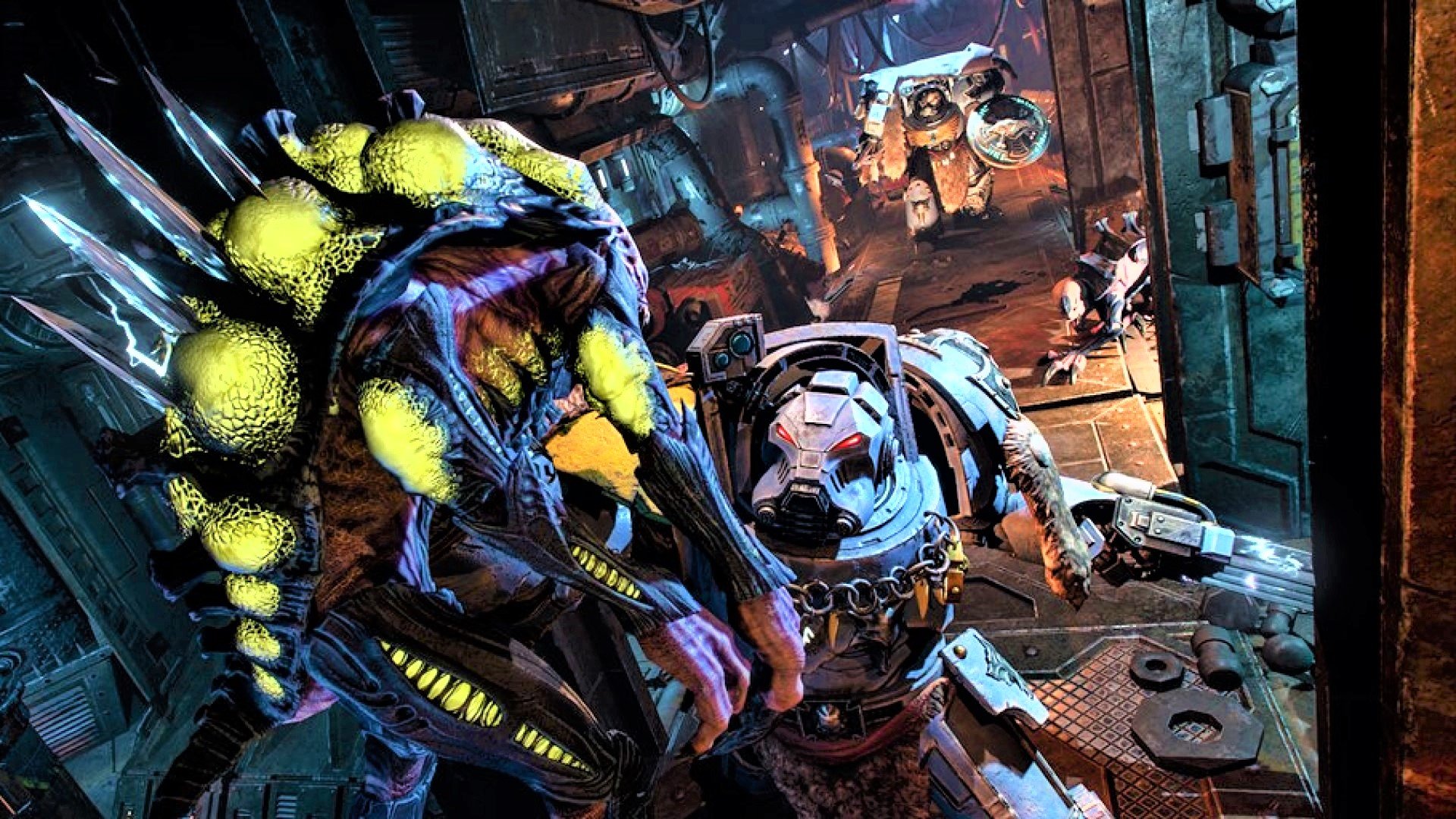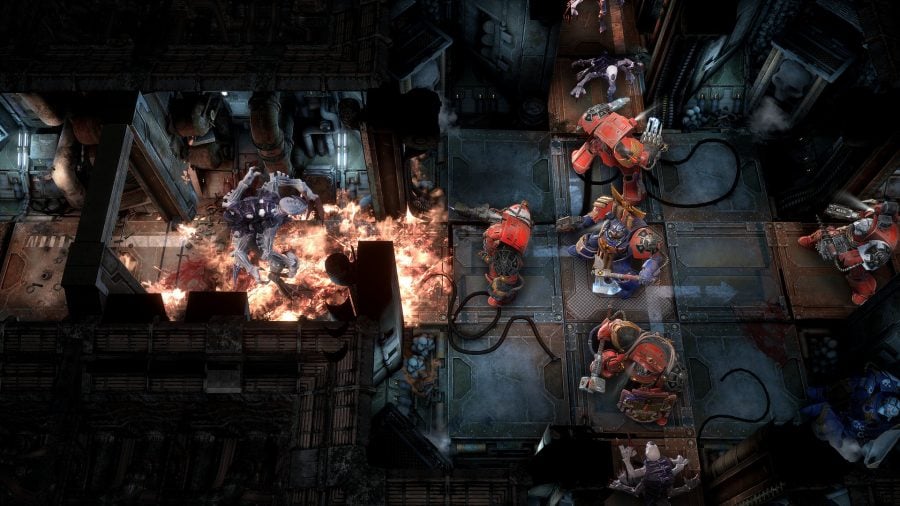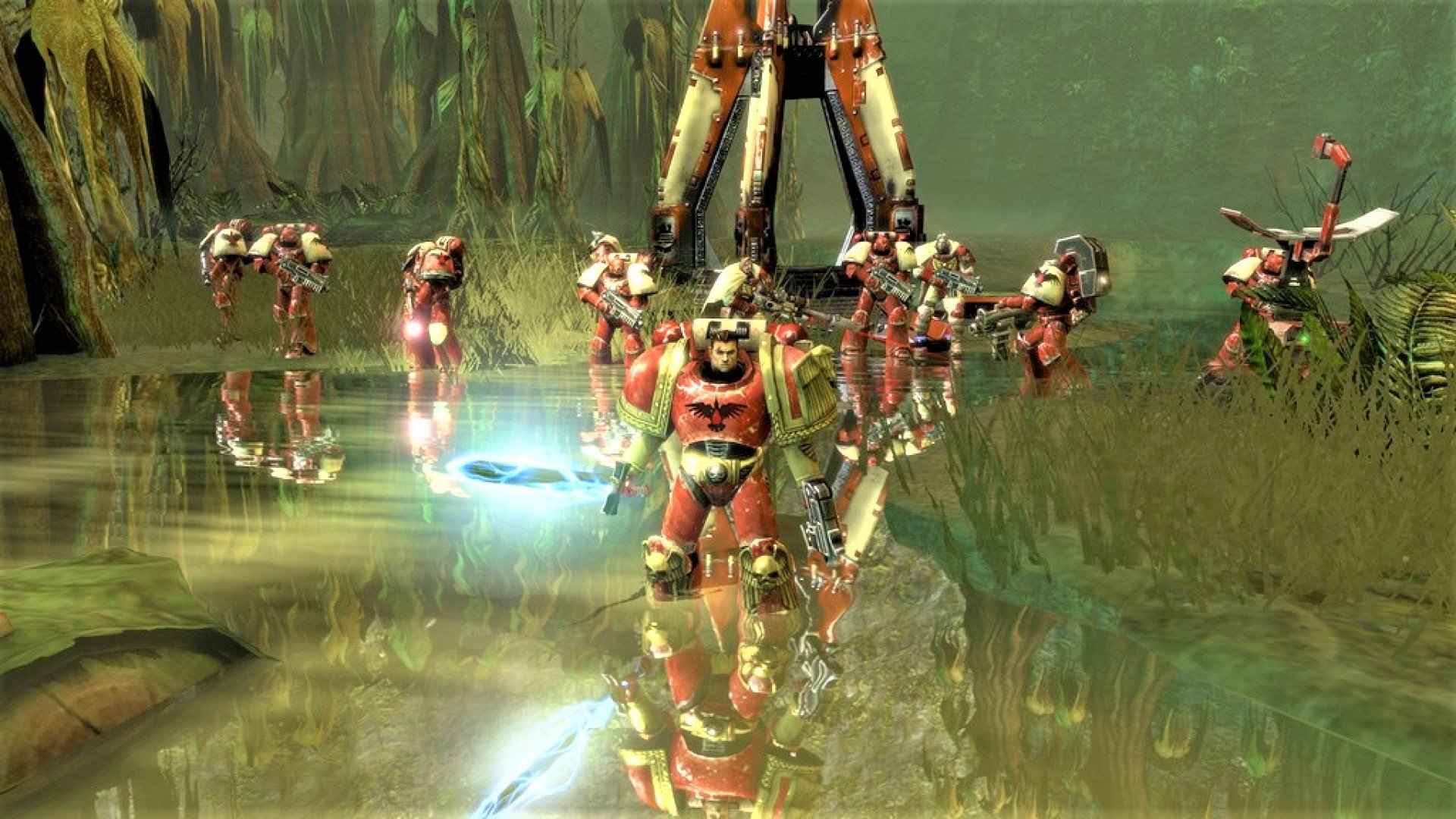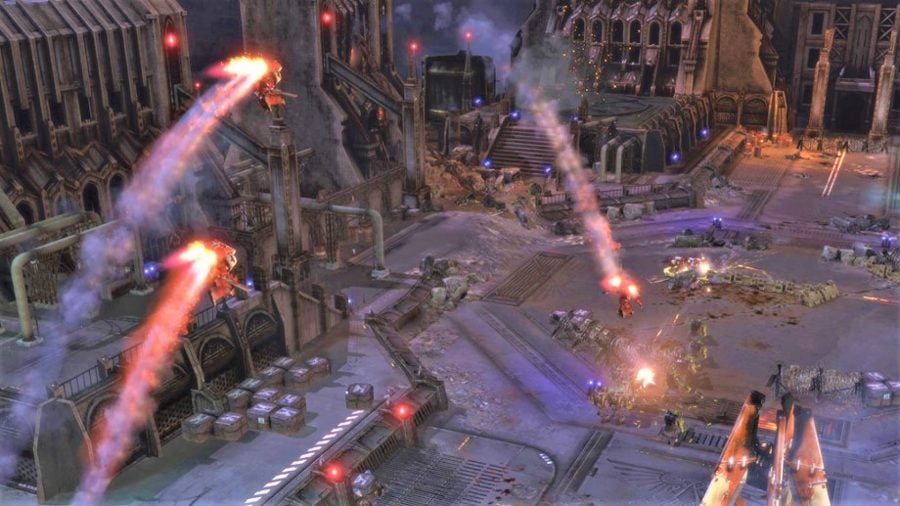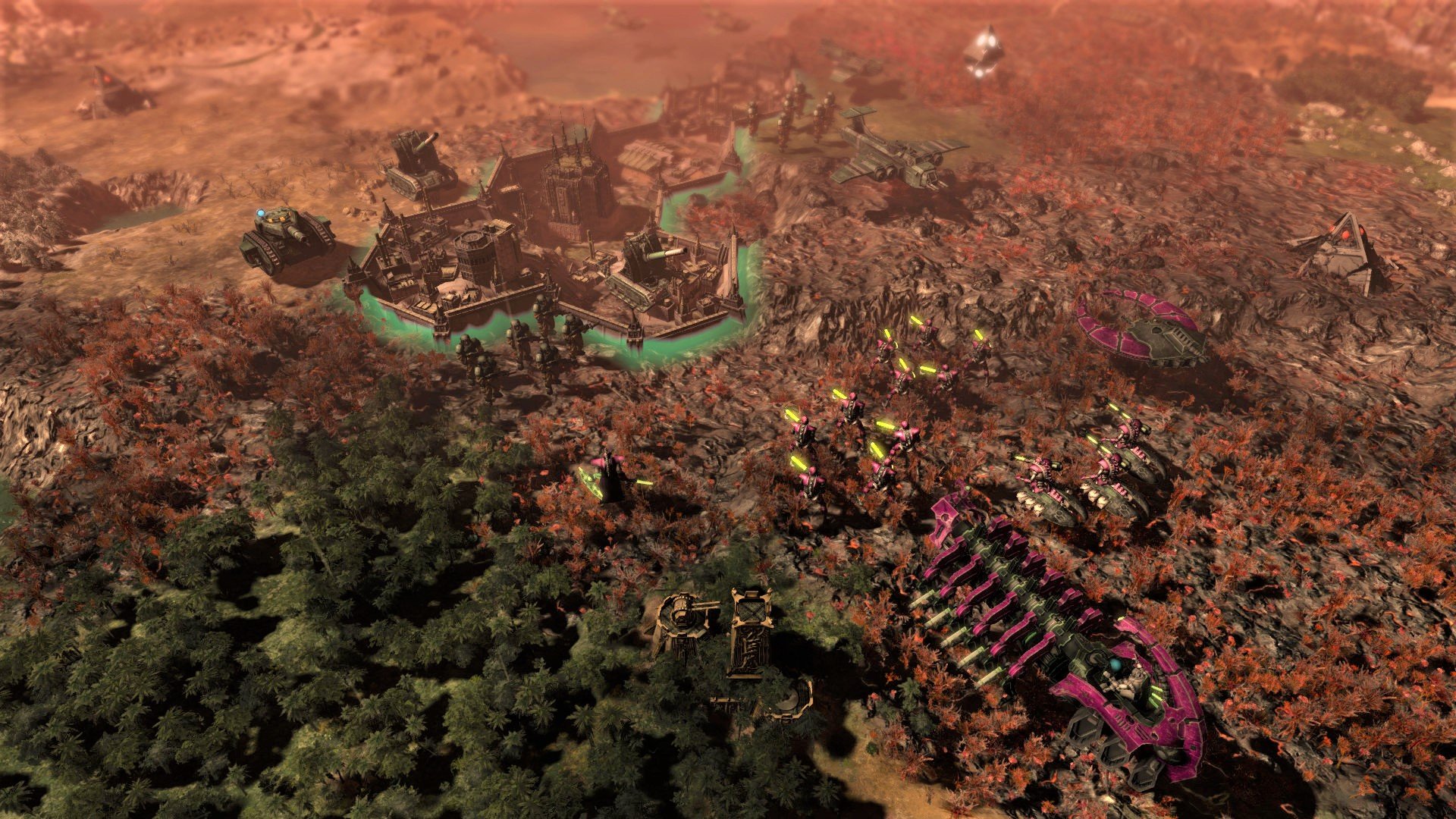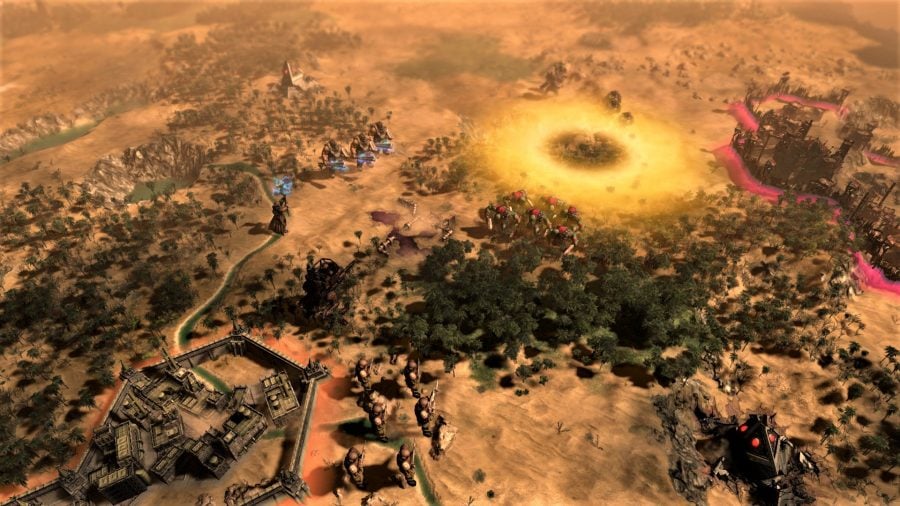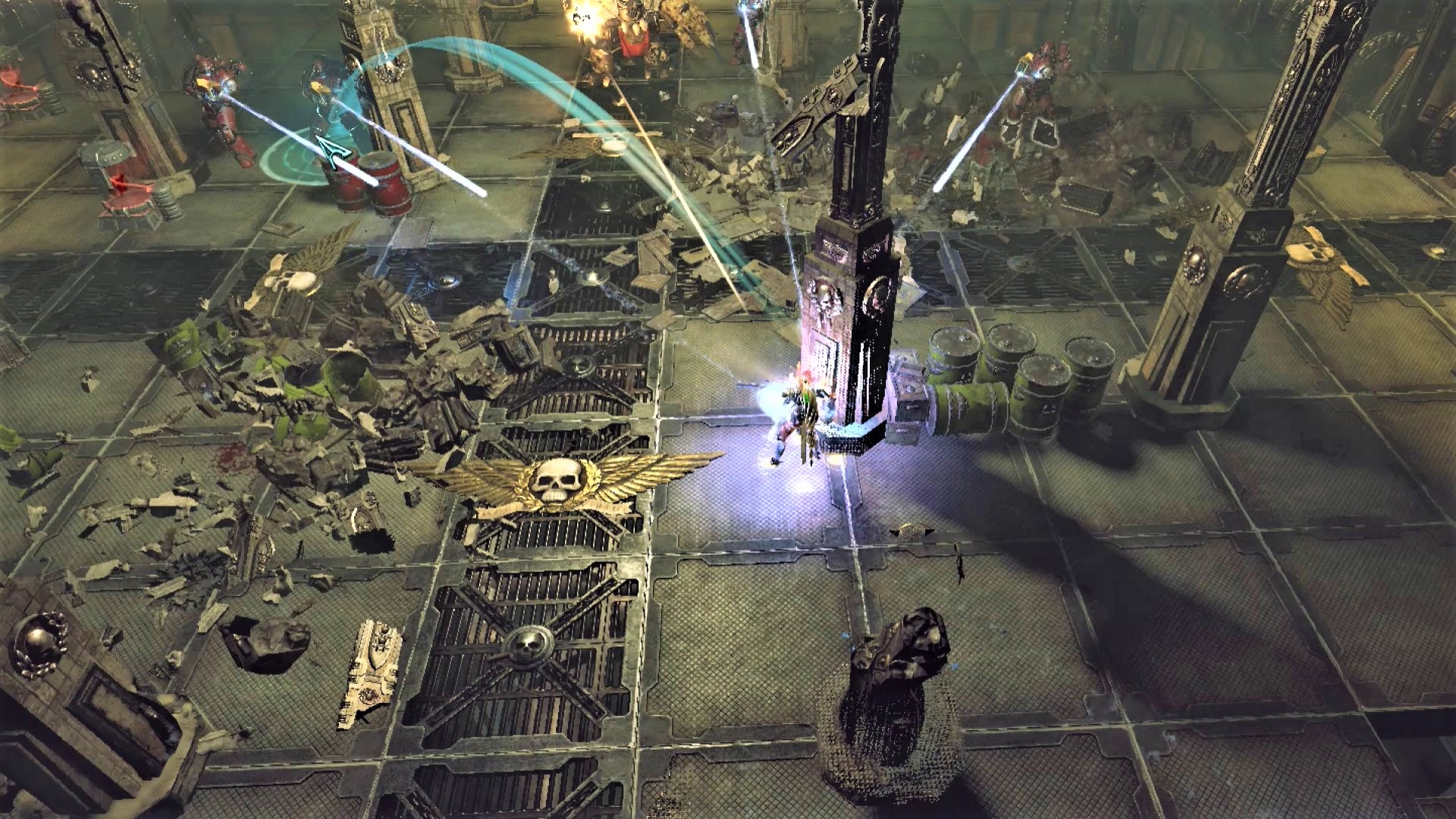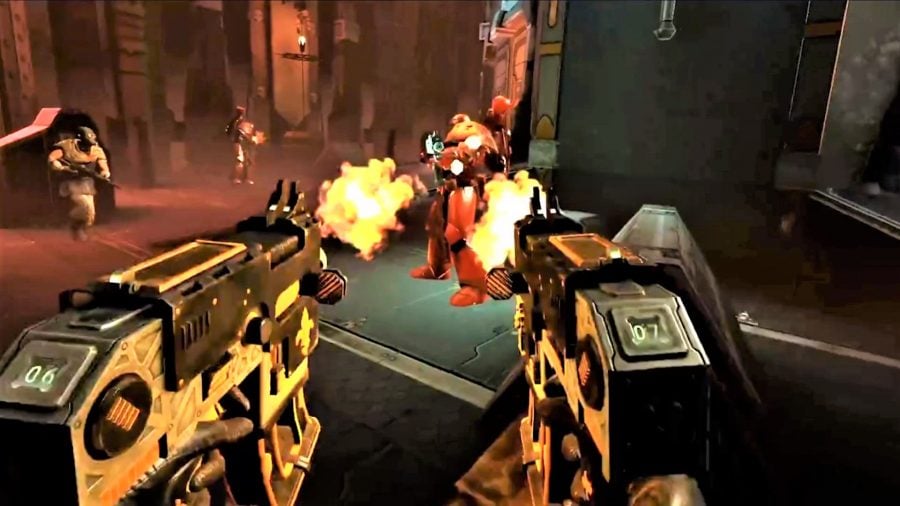Warhammer 40k games get a bad rap. In the 36 years that Warhammer 40,000 has been filling dining room tables with green-skinned cockney aliens and colourful, massive-shouldered Space Marines, the setting has spawned at least 50 digital games. For a long time, most were disappointing flops that failed to capture that 40k tabletop magic – but these days we’re seeing more and more awesome, must-play 40k videogames come out – and this guide profiles the very best of them.
These 41st Millennium bangers span quite a few different Warhammer 40k factions and almost every videogame genre, from RTS games, to sprawling 4X games, to turn-based strategy games, to co-op shooters, and even a VR game. There are new 40k titles coming out all the time, too, so watch out for new additions – but, for now…
The best Warhammer 40k games in 2023 are:
Darktide
If you’re a fan of both co-op multiplayer FPS games and Games Workshop’s grim, dark, bloodstained far future, Warhammer 40k Darktide will blow your mind (especially when playing as the psyker character, who can literally blow enemies’ minds by exploding their heads with concentrated warp energy).
Released in November 2022 by developer Fatshark, Warhammer 40k Darktide is effectively a Warhammer 40k flavored reincarnation of its bestselling co-op slash-em-up Vermintide 2, which was based in the Warhammer Old World fantasy setting. This time, instead of a DnD style adventuring party battling infestations of Skaven ratmen, you play members of an Imperial Inquisitor’s warband, completing various missions in a hive city that’s overrun with servants of the Warhammer 40k chaos god Nurgle.
Each of the Darktide classes offers a different core ability and playstyle, its own variety of guns, armor, and wargear, and a different library of conversational voice lines that’ll play out in procedurally generated conversations between the characters as you fight through waves of chaos-warped enemies, complete challenges, and fight disgusting bosses.
The voice lines can start to grate a little over time, but there’s enough variety that it still works well (and it helps that the voice acting and writing are both excellent, with superstar Black Library and Horus Heresy author Dan Abnett on the team).

The game’s environments are frequently stunning, and an impressively faithful, atmospheric rendering of 40k’s unique aesthetics. You’ll be fighting through the spires and flying buttresses of futuristic gothic rooftops one mission, and trudging through oppressive, grimy industrial undercities the next. It’s by far the best visual simulation of the Warhammer 40k world we’ve seen in a videogame.
Darktide had a rocky launch, with a host of performance and connection issues that have taken a long time for the small studio to fix – which seems to have delayed plans for a series of post-launch content and story expansions. That, combined with a lack of variety in the high-level gear available, has led to fans crying out for a better end-game experience to keep them playing.
Only time will tell whether Fatshark delivers on that – but even with those caveats, Darktide is easily one of the best Warhammer 40k games of all time, and well worth playing.
Chaos Gate Daemonhunters
In our books, Warhammer 40k Chaos Gate Daemonhunters just steals the crown from Mechanicus as the best game like XCOM set in the 40k universe. In Daemonhunters, you take command of a strike force of Grey Knights – elite, secretive chapter of Space Marines that are all psykers, and use their psychic might and advanced wargear to combat incursions by Chaos Daemons.
Closely following the tried and tested XCOM format (build your base, train and equip a team of soldiers, and deploy them on various missions to hold back an oncoming, apocalyptic threat), Chaos Gate Daemonhunters pits you and your psychic marines against the spread of a new, deadly galactic plague cooked up by the chaos god Nurgle.
The various different classes of Grey Knights available for your roster (as well as the Duty Eternal DLC’s Venerable Dreadnought and Imperial Assassins coming soon with the upcoming Execution Force expansion) each offer different skill trees to upgrade and specialise throughout the game – so long as you keep them alive. Combine that with a ton of unlockable weapons and wargear items, plus cosmetic customisation options coming out the wazoo, and you’ve got a ‘war-barbie’ experience second only to collecting and painting warhammer in real life.

Like others in the genre, Chaos Gate Daemonhunters’ race-against-time campaign is a tough strategic challenge, forcing you to manage limited resources and prioritise your missions carefully against a stronger, better-resourced, ever-growing opponent – and the turn-based tactical battles are no cake walk either.
In a twist on the XCOM DNA, your superhuman Space Marines’ shots will always hit their target (no soul-crushing percentage hit chances here) and you’re given a lot of handy contextual information to inform your tactics, including advance notice of how much damage your shots will deal out from a given movement destination, before you make that move.
On the other hand, every few turns, you’ll hit a Warp Surge – granting your Nurgle-loving enemies a random chaos boon, ranging from temporary damage boosts to mid-game reinforcements joining the battle. Every mission is a potentially punishing battle that rewards quick thinking, aggressive tactics, and canny use of specialists’ abilities; it’s excellently done.
Like XCOM 2 before it, Daemonhunters can be an exhaustingly intense experience, where losses are all but inevitable, and often crushing – but the blend of strategy and tactics is on point, the core gameplay is very satisfying, and the Warhammer 40k lore background well realised. If you like both XCOM and Warhammer, this is a truly essential game. For full details, see our Warhammer 40k Chaos Gate Daemonhunters review.
Dawn of War
Back to the classics now: 2004’s Dawn of War and its 2009 sequel are two sublime real-time strategy giants that each, in their different ways, embody the themes and virtues of 40k, and stand up on their own as excellent games in their genre. But the original remains, to this day, a palpably bigger beast among Warhammerites at large, and a titan of the era of games like Age of Empires.
When critics reflect on Dawn of War II, it’s as an experimental, genre-mixing sequel which reached great heights, but turned some players off. When they look back at Dawn of War, it’s as a much-missed, pre-eminent paragon of the classic base-building RTS era, standing shoulder to shoulder with PC strategy demigods like Starcraft 2 and Age of Empires 2, now increasingly lost in an avalanche of MOBAs and roguelike hybrids.
That conceptual purity (along with a generous glug from Warhammer fans’ nigh-inexhaustible reservoirs of nostalgia) gives the game a perpetual, ineffable shine of authenticity, and a whiff of historic grandeur.
Which is interesting, because it wasn’t, in its time, particularly revolutionary. It’s a lot like any other late-nineties, early-noughties RTS. You build a base (town centre, barracks, tech up, oh my), you train units, you march them at the enemy and, if you play your rock-paper-scissors right, you eventually kick over their sci-fi sandcastle and jubilantly hammer ‘GG’ into the chat box.
Where developer Relic struck gold was in the ways it simplified and streamlined those mechanics. Each click produces a neat squad of infantry, for example, instead of individual figures that have to be cursor-lassoed together. Resources come from taking and holding battlefield strongpoints, not faffing with ancillary farmer units. Base-building is lightweight, strongly focused on unlocking military units and upgrades. This game, like its tabletop counterpart, wanted you to leave the admin at home, get out there, and make war.
And, more importantly than all of that – it got the feel right. Dawn of War was passed carefully and thoughtfully through a pitch-perfect sieve of 40K-ification – adding just enough lore-appropriate flavour to sate players with a shelf full of lovingly painted Dark Angels right above their monitor, but not so much as to confuse others, or bog down the game’s inherent strengths as a fast-paced, aggressive RTS. The balance was spot on – and it still is.

These days, with this venerable title now old enough to drive a car and enlist in the US army, we know we’re viewing it through slightly rose-tinted helm-lenses.
But with a rock-solid gameplay foundation, a satisfying, authentic 40K storyline, and a suite of blockbuster expansions that’s arguably second to none in all of RTS history, we can confidently say Dawn of War is a stunner – easily a contender for the finest Warhammer computer game of them all.
Dawn of War II fans: fear not, for the Emperor always provides. Read on, and you’ll find your favourite has an entry all of its own – but not before…
Space Marine
Warhammer 40,000: Space Marine, the epic, gore-drenched odyssey of Ultramarines Captain Titus achieves something Warhammer computer games almost never can: it actually makes us care about its main character. Are we saying that Relic Entertainment’s unrepentantly ultra-violent, unsubtle third person action slaughterfest from 2011 has some kind of deep, nuanced or intelligent story? Absolutely not, don’t you worry, it’s dumb as heck.
We don’t care about Titus because he’s interesting, or has a conflicted and tragic backstory, or gets mixed up in complex and thrilling goings-on that unfold before our eyes.
Quite the contrary, as the goings-on are as run-of-the-mill as 40K gets: you go to a human factory planet besieged by Orks, kill thousands of Orks, realise it was Chaos’ nefarious doing all along, kill the Chaos leader, the end, then it’s straight home for tea and nutrient paste.
No, we care about Titus because he’s the most impressively realised, most relatable and believable Space Marine warrior ever in a videogame, and, by placing us in his massive ceramite boots, this game gets closer than any other to recreating on screen the peculiarly gripping power fantasy of being a transhuman Astartes warrior.
Titus’ 9-foot-tall, 6-foot-wide bulk towers over human-sized NPCs and scampering greenskin enemies alike, making you feel like one of the magnificent gods of war so reverently described in Black Library novels. Every decibel of his voice – the inimitable and inexpressibly perfect booming tones of Mark Strong – projects the grave, dutiful assiduousness of an Ultramarine. His every animated step, lunge, swing and leap is perfectly tuned to feel impossibly powerful and weighty, conveying an uncanny sense of superhuman heaviness that makes Gears of War seem a bouncy, air-filled platformer by comparison.
The game’s atmosphere is treacle-thick, bloody, and intoxicatingly 40K. While the environments are an endless succession of near-identical corpse-strewn industrial zones, it really, honestly doesn’t matter, because all you’ll care about is the banging of your boltgun’s explosive shells and the rhythmic roar of your chainsword swinging up and down, carving Orks into vaguely Christmassy green-and-red jelly.
Space Marine – also by Relic Entertainment, and available on PC and console still – is required gaming for 40K fans because, more than any other title, it gets, on a deep level, the particular escapism baked into Games Workshop’s pre-eminent sci-fi ‘heroes’ – gigantic shoulder pads and all.
Ork players may be less enamoured with the experience, mind.
Battlefleet Gothic: Armada 2
In the grim darkness of the 41st millennium, there is only war – this we know. But the vast majority of its many tabletop and digital simulations tend to focus on ‘grounded’ fighting, whether that be on the surface of embattled planets, inside the tossing, red-lit corridors of a freshly-boarded warship, or deep within the pitch-dark, drifting belly of a Space Hulk.
Not so amid the cosmic naval warfare of Battlefleet Gothic, first launched as a spaceship fleet-based miniatures game in 1999, and revived for PC by developer Tindalos in 2016, three years after the dwindling tabletop line was finally canned by Games Workshop. Taking command of flotillas of 40K’s preposterous spacefaring warships – mainly colossal, flying gothic cathedrals whose designs feature significantly more buttresses, spires, and crenellations than concessions to practical warfare or the laws of physics – you’ll fight a series of ship-to-ship battles on a fixed horizontal plane, against vessels from a selection of humanity’s many deadly enemies.
You’ll swiftly get the impression that you could swap your plough-fronted space-battleships for 19th century ships of the line and the gameplay wouldn’t change in the slightest – which, of course, is entirely true (well, except for the asteroids and boarding pods filled with Space Marines) and we’re absolutely fine with that.
Tindalos’ 2019 sequel is the best execution of strategic void warfare yet, adding a wider cast of Chaos and Xenos navies to either command or lay waste to, and fully fledged campaigns played from the perspective of the all-consuming Tyranid Hive Fleets, and the awoken robotic menace of the Necrons, to counterpoint the human-centric main event.
Gameplay is a surprisingly immersive affair for 40k fans, with each faction aptly portrayed through super-detailed 3D craft, and well-written, well-performed voice acting. Naturally, it’s all a particular joy for those who adore the Warhammer novels that lean hard into void combat scenes, using phrases like “deadly cosmic ballet” a lot.
For the sake of an altogether different view on Warhammer 40k’s nightmarish galaxy of eternal war, Armada 2 absolutely makes it worth your while to take a spell in the command throne of an Imperial Navy Cruiser, or at the spearhead of a dread Necron Tomb Fleet.
When you unleash your first killing broadside into an enemy vessel, overwhelming its void shields and tearing its great iron belly open to the pitiless vacuum of space, you’ll know what we mean.
Mechanicus
The Adeptus Mechanicus is a faction of mysticism-prone, technology-worshipping cyborgs from Mars, whose prevailing mission is to amass hoards of technological wisdom and understanding – primarily by scouring the galaxy for rare, complex or esoteric gadgets, stealing them, and taking them home to tinker with in the garage for the rest of time.
This, in a nutshell, is the plot of Kasedo Games’ 2018 turn-based tactical squad battler, Mechanicus. You take command of a small but growing squad of Adeptus Mechanicus tech-priests, tasked with exploring worlds in search of hi-tech plunder. So far, so good. Once you get down to the surface, though, things start getting all spooky, geometric, green, and glowing real fast. Those subterranean treasure vaults you saw on the scanners were, it seems, actually stasis crypts full of Necrons – soulless, ancient robotic killers – and they are none too pleased to be woken up by a bunch of half-organic grave robbers trying to nick their laptops.
So begins your distinctly XCOM-inspired progression through a series of increasingly challenging – but quite similar – grid-based maps, carefully managing your tech-priests’ limited action points to complete objectives, while avoiding vaporisation in the neon green beams of Necron gauss weapons.
Mechanicus hasn’t earned a place in this list for having outstanding gameplay (although its enjoyable, if unremarkable team-tactics fare still places it far above the median line among 40k titles). Rather, it’s here because of its strikingly faithful, vivid, and unapologetically weird portrayal of the Adeptus Mechanicus – a lovably eccentric but fairly high-concept sci-fi faction that it would have been so easy to deal with in a half-arsed way.
From the characters’ campy, cyborg-ish names made up of jumbled numerals and Greek letters, down to the fizzling data-blurts of their part-sonic, part digital language, Kasedo did the AdMech properly. So, if you like the sound of lightweight, XCOM-alike gameplay with easy-going puzzle elements, battling cyber-mummies in a dusty crypt, and having USB sticks for fingers, this is the one for you.
Space Hulk: Tactics
Anyone who encountered Warhammer 40,000 of old – we mean, back in the… *gulp*… nineties – will have heard the name Space Hulk. Games Workshop’s original Space Hulk board game released in 1989 to some acclaim, pitting the Space Marines’ elite Terminator warriors against scythe-clawed alien fiends in a lightless, terrifying cosmic shipwreck.
Subsequent editions in 1996, 2009, and 2014 sold well to a growing cult audience, especially 2014’s fourth edition, which arrived right amid the upswell of Warhammer’s grand resurgence. Space Hulk on the tabletop, therefore, has earned its place as one of Warhammer 40K’s most distinguished and popular games. The digital adaptations? Not so much. There are no fewer than eight videogames bearing the Space Hulk name (if you count its 2005 outing on the Nokia N-Gage), but none has made an impact anywhere near the scale of their board-based grandpappy – none, that is, except developer Cyanide’s breakout 2018 adaptation, Space Hulk: Tactics.
Fundamentally, Tactics is simply a faithful, direct remake of the board game, merely adding the small matter of some absolutely drop-dead-gorgeous 3D graphics to turn out a perfectly potable PC and console port. But Tactics also adds a subtle but powerful shot in the arm, in the form of its cards system, granting you a hand of upgradeable cards to further customise your chosen team of Blood Angels’ abilities, and, when played, hopefully turn the tide of battle at the game’s crucial moments.
Add to that the twin campaigns – one seeing you control the Blood Angel Space Marines against the Genestealers, the other flipping the table to control the ‘Nids against Ultramarines Astartes on the same ship, but centuries earlier – and you have yourself a digital tabletop party without compare. If you like 40K, slick digital board game adaptations, and spending multiple hours no more than a few grid squares away from slavering alien bioweapons that want to eat your organs, you’re in the right place. Recommended.
Dawn of War 2
You see, we told you we’d come back for you! In every Warhammer 40k videogames thread, a divide quickly forms between those reformists who prefer the squad-level, RPG-inspired narrative campaigns of Dawn of War 2, and the base-building competitive RTS purists, for whom the first game is an insurmountable masterpiece, and the sequel an ill-considered damp squib. Truly, this is a case of the old adage ‘horses for courses’, for each game is superb in its own right – but each lends itself to a very different style of play, and aims to create different kinds of experience for the player.
Relic’s breathlessly-awaited Dawn of War sequel, released five whole years later in 2009, distils, streamlines, nips and tucks the traditional RTS original to create an altogether different beast. Sprawling, wide-open maps are squeezed down into graphically lusher, but completely linear, railroaded environments.
The quickly-snowballing hordes of units you once flung across the map with abandon are replaced with just a couple of persistent squads, led by named characters, with RPG-like equipment upgrades, and skill progression mechanics. Base-building is all but erased from the game, buildings reduced to inert terrain pieces from which to respawn your (very limited) support units, should they fall.
But, despite what the Dawn of War 1 purists say, in this case, less is in many ways more. DoW2’s narrower focus gives it more room to expand from the original’s faithful, yet somewhat superficial portrayal of the 40K universe, baking more detailed storytelling, character interactions and dialogue into the mission-to-mission gameplay, rather than just CGI cutscenes.
You’re able to select from a choice of squads to take on each sortie, decking each out with different wargear and skills each time to mix up their in-game tactics, and finding out what works best for you, which – frankly – is a whole ton of fun.
It’ll soon have you picking your favourite squads over others, getting a feel for their abilities, their tactical utility, their weaknesses, and their leaders’ occasional witty banter, both on- and off-mission. This draws you into the game’s storytelling in a way that’s entwined with the gameplay, rather than tacked awkwardly onto it, as is so often the case in classic RTS campaigns.
We could go on for pages about the innovative storytelling in DoWII, its beautifully-constructed missions, and the ingenious, maddeningly addictive and shockingly ahead-of-its-time Last Stand horde mode, but, honestly, your time would be better spent just playing the game. Just go and get it, right now. We mean it.
Gladius – Relics of War
Warhammer 40k, as a tabletop miniature wargame, is all about the fighting. You assemble an army from hand-picked units of two-inch-high plastic soldiers, deploy them appropriately on the table for your carefully-planned strategy, and then enact your battle plan to destroy the enemy over subsequent turns of dice-rolling, nail-biting, and cursing the fickle gods of fate.
Conquering entire continents, constructing cities and fortifications, and managing economies to raise, and steer into battle, multiple grimdark armies, feels like a vast, and perhaps sisyphean task by comparison – but that is the premise of Gladius – Relics of War, developer Proxy Studios and publisher Slitherine’s bloody good crack at a Warhammer 40K 4X wargame, released in 2018.
If you’ve not heard of 4X, it stands for Explore, Expand, Exploit and Exterminate – your four key tasks as you establish, then grow, your 41st-millennium planetary empire, developing cities and training stacks of Necron Warriors or Tactical Space Marine units just as you might Spearmen or Archers in a game of Sid Meier’s Civilization VI. It does, honestly, feel just a little bit odd transplanting this city-settling, infrastructure-building, ‘one more turn’ model of strategy to the usually frenetic, wartorn setting of 40K.
But, on the whole, Gladius works surprisingly well. The visuals are gorgeous, if let down by some unremarkable and slightly immersion-breaking janky animations (it ain’t no Civ in that department) and, while those hoping for hardcore wargame levels of mechanical depth will come away hungry, there’s enough meat to the factions’ tech trees and progression to provide a respectable, if quite easy-going strategy package overall.
If you’re a 40k fan who cut their strategy gaming teeth on Civilization (on a lower difficulty setting, at least) don’t sleep on Gladius; there’s a lot of fun to be had here.
Inquisitor: Martyr
Neocore Games’ 2018 action-RPG (think Diablo or Path of Exile, but with sci-fi and guns) Inquisitor: Martyr casts you as an agent of the Imperium’s shadowy, pseudo-religious, paramilitary secret police force, the Holy Inquisition. Arriving aboard a benighted space station to investigate some suspicious signals, you’ll soon embark on a broader quest that sees you travel to other parts of 40k’s grim, dark galaxy, exploring some fine-looking 3D-rendered isometric maps, and obliterating numberless hordes of Chaos-worshippers, heretic astartes, daemons, xenos and other assorted foes of Him on Terra.
In a manner wholly familiar to anyone who’s played more than ten minutes of Diablo II, you’ll gather up shiploads of weapons, gear, upgrades, and consumables from your enemies’ mortal remains, upgrading your loadout by equipping the cream of the crop, and recycling all the rest.
There’s more than enough abilities to unlock and try out, arranged in three different class trees (shooty, stabby or psyker) to encourage multiple playthroughs and different character builds – but don’t expect it to have the endless replayability of a Diablo, or the longevity and content library of a pure-bred live service game like Path of Exile. It all feels just a little…thinner than that.
Inquisitor: Martyr isn’t the first stab at a Warhammer 40K ARPG, but it’s the first to do the concept justice, with a very serviceable and satisfying ‘looter shooter’ core gameplay loop, impressive environments filled with suitably gruesome enemies, and an overall audiovisual experience that gets Wargamer’s “Proper 40K” wax purity seal of approval. Absolutely worth your time, with enough content now released that it should keep you busy for quite a while.
Battle Sister
We know, we know, it’s not reviewed tremendously well – and September 2020’s virtual-reality shooter Battle Sister, from developer Pixel Toys, does have some glaring flaws. Like many VR titles, it’s pretty short, and its on-the-rails FPS gunplay is made to feel all the more perfunctory, at times, by some extremely basic AI.
Depending on their weaponry, enemies will tend to either stand stock still and take potshots at you from cover, or rush directly into your face, with little in between. The story is nothing to write home about, either, and neither your Adepta Sororitas battle-nun protagonist Sister Ophelia, nor your primary in-game ally (a Black Templars-chapter Space Marine) gives you much reason to care about them.
Nevertheless, the title deserves its spot on this list because – and we can’t stress this enough – it’s a properly functioning Warhammer 40k shooter in VR, that really exists, that you can buy and play, today, on earth. Let that sink in for a moment.

Though all the fundamentals of the game may be markedly mediocre, the sheer thrill of a game that, more than any pancake monitor screen, allows you to truly hold the grip of that boltgun, flamer, or meltagun as you empty its ammo into a shrieking Chaos daemon two feet from your face; a game that has your arm drive the fizzling power sword blade hilt-deep into that Chaos Space Marine’s horned faceplate – that’s priceless, precious 40K treasure.
Siblings, don your thrice-blessed Oculus headset, and scream your battlecry so the Emperor himself can hear you, because this is Warhammer 40k videogaming at its very realest – and if this is the first foray, we can’t wait to see what’s coming.
Source: Wargamer



